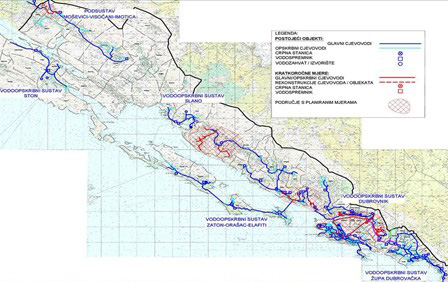Water supply and wastewater collection and treatment infrastructure is being upgraded in and around Dubrovnik, Croatia. Work on water supply mainly covers Dubrovnik, but also includes districts supplied by the Zaton-Orašac-Elafiti and Mioševići-Visočani systems. The wastewater section of the project covers Dubrovnik alone.
Upgrades to water supply and wastewater systems in Dubrovnik, Croatia
- 13 January 2021
By addressing deficiencies in the water supply and sewerage systems, the project helps to ensure compliance with the EU drinking water, urban wastewater treatment, groundwater and water framework directives.
Extension, construction and renovation
The supply network will be extended by 25.5 km, while 9.5 km of the existing network will be rebuilt and 5.2 km will be renovated. In addition, the project entails the construction of a treatment plant at Ombla, four pumping stations and two reservoirs. One reservoir will be reconstructed and another renovated.
For wastewater collection, 22.5 km of gravity sewer and five pumping stations will be built, 1 577 network connections will be set up, 358 m of gravity sewer and one pumping station will be rebuilt and 7.9 km of gravity sewer and five pumping stations will be renovated. Gravity sewers rely on a difference in elevation to ensure that sewage flows to treatment plants.
For wastewater treatment, the Lapad plant, which only provides mechanical treatment, will be upgraded to allow it to perform secondary treatment. It currently has the capacity to handle pollution loads equivalent to those normally produced by 50 000 people. This figure is insufficient and will be increased to 73 000. Also, the plant’s sea outlet will be reconstructed and a solar sludge drying facility will be built at Osojnik.
Six vehicles, an excavator, mobile pumps and pumping equipment and high-pressure jetting machinery will be acquired under the project.
Current problems
Dubrovnik has a population of around 40 000 and Dubrovnik-Neretva county is a major tourist destination. It hosts some 8 million overnight stays a year, half of them in Dubrovnik.
Approximately 8.7 million m³ of water is produced annually in the area, of which 6.1 million m³ comes from the Ombla source. The water is sometimes cloudy, particularly after heavy rain. Improved treatment should help to resolve this.
Treated water from Ombla is pumped to the main distribution system through a 3 km-long tunnel, which is reportedly in poor condition. The ageing supply network and the type of material used for pipes are the principal causes of water losses.
The wastewater infrastructure problems arise from high levels of storm and sea water entering the system and from the poor condition of pumping stations.
More connections, fewer losses, less pollution
Thanks to the project, a further 967 inhabitants will be connected to the supply network, bringing connection rates to around 99 % in the Dubrovnik system and 98 % in the Zaton-Orašac-Elafiti system.
Water losses will be reduced from 38 % to 30 % in Dubrovnik and from 34 % to 28 % in Zaton-Orašac-Elafiti. In districts served by the Mioševići-Visočani system, the investment will ensure adequate quality drinking water for residents supplied from Bosnia and Herzegovina.
Domestic sewerage connection rates in Dubrovnik will be increased from 84 % to 92 %. All the area’s wastewater will be transferred through the network, or from septic tanks and treated at Lapad.
The upgrades will cut pollution, enhance the region’s attractiveness and lower barriers to economic development, notably in the tourism sector, thereby leading to job creation. The project itself creates 40 temporary jobs in the construction phase and six permanent positions during the operational stage.
Total investment and EU funding
Total investment for the project “Development of the communal water infrastructure – Dubrovnik” is EUR 115 948 510, with the EU’s Cohesion Fund contributing EUR 60 216 440 through the “Competitiveness and Cohesion” Operational Programme for the 2014-2020 programming period. The investment falls under the priority “Environmental protection and sustainability of resources”.

